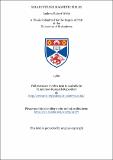Solar intense magnetic fields
Abstract
The nature of motions in intense magnetic fields is investigated. For a flux tube in a uniform atmosphere a dispersion relation is derived for the modes of vibration and analytic approximations are obtained for a slender tube. In a stratified atmosphere an expansion procedure is used to derive an equation for the vertical velocity perturbation. The behaviour of motions within the flux tube is shown to depend upon a transition frequency 𝜔[sub]v such that vertically propagating waves are possible only for frequencies greater than 𝜔[sub]v. Also, the nature of convective instability in a slender magnetic flux tube is explored. A sufficient condition for stability is derived for the case of an arbitrary temperature profile in the external medium. For a tube of infinite depth, with a uniform-temperature gradient inside the tube equal to that in the exterior, a necessary and sufficient condition for convective stability to occur inside the tube is derived. Under the assumptions of the model, intense flux tubes are convectively stable if sufficiently shallow (with depths 1 - 2 x 10³ km or less). Tubes that extend deeper into the convection zone are potentially (convectively) unstable, but may be stabilised for sufficiently strong magnetic fields. Radiative damping of waves is important in the upper photosphere and the effect of radiative relaxation on the propagation of waves in an intense flux tube is examined both for a uniform and stratified atmosphere. The cut-off frequency is generalized to include the effects of radiative relaxation. The phase-shift between velocity oscillations at two different levels and the phase difference between temperature and velocity perturbations are derived and compared with the available observations. Finally, the consequences of the observed steady downflow are discussed.
Type
Thesis, PhD Doctor of Philosophy
Collections
Items in the St Andrews Research Repository are protected by copyright, with all rights reserved, unless otherwise indicated.

